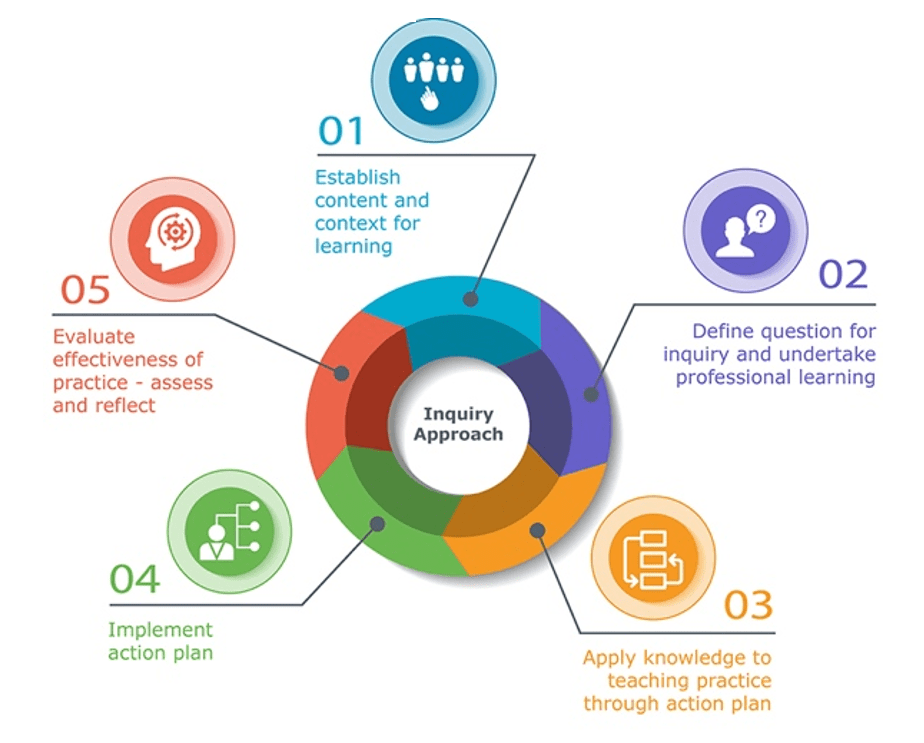
By Kayla Kelly
EDITION #10 – From graduate to mentor: completing the Victorian Institute of Teaching (VIT) inquiry
Published – 16th October 2019
Kayla teaches at Featherbrook K-9 College in Point Cook.

Introduction
As a graduate teacher there seems to be a never ending list of things to do, people to see, emails to respond to, and professional learning to attend. Questions about what the Victorian Institute of Teaching (VIT) inquiry involves and the expectations around gaining full registration are also likely to be swirling around. You may be feeling uncertain about the many decisions you need to make.
Having been through the process myself, my advice is to pause, take a step back and celebrate all you have achieved so far. View the VIT inquiry as an opportunity to reflect on and further develop your teaching practice, while improving your ability to support all learners.
As a provisionally registered teacher (PRT) your task is to undertake an inquiry approach (VIT, 2019b) to develop your practice and collect evidence that you meet the Australian Professional Standards for Teachers (VIT, 2019a) at the Proficient Teacher level. I have set out below some steps that I hope will help you complete this task.
The Cycle of Inquiry
You will find the diagram below on the VIT website( https://www.vit.vic.edu.au/registered-teacher/moving-to-full-registration/inquiry-approach), but it is reproduced here so that you can link my comments to the phases of the inquiry cycle.

1. Establish content and context for learning
During the early stages of the year, you will have established that your school has a distinct context. This involves the structures, student characteristics and overall unique situation of the learning environment. There are a specific range of needs, backgrounds and abilities within your school. The initial focus of the inquiry asks you to identify these qualities. What are the key features that define your learning context?
Remember to keep it simple, focus on the number and range of students, as well as the impact of cultural diversity. In this section it also requires you to select learners to focus on within the inquiry cycle. Consider the needs of the individuals within your learning space and identify a select few that you will document in greater detail. Within your group of selected learners or in the larger cohort of learners, you must identify at least one with disability that requires you to modify your practice to address their additional learning needs. You should also consider whether you are working with Aboriginal or Torres Strait Islander learners.
2. Define question for inquiry and undertake professional learning
In refining a key inquiry question, first look at the needs of the students you have selected. In doing so, you will ensure that your goal is relevant to your teaching context and everyday practice. Secondly, always remember that your question is not set in stone. Throughout the inquiry process you might find the need to adapt your teaching and learning strategies as they relate to your question. More can be found on the VIT website on how to formulate an inquiry question, and particularly how to ensure it is a SMART goal.
If you are finding it difficult identifying a focus for your inquiry talk to your peers, identify common areas of need, and consider the priorities of the school by looking at the current Annual Implementation Plan. You might also find the High Impact Teaching Strategies (HITS; Department of Education and Training, 2017) helpful in refining your inquiry:
- Does my question align with the high impact teaching strategies?
- Could I further refine my question by including key high impact teaching strategies?
From here, you will engage in a series of observation and feedback cycles. The Peer Observation, Feedback and Reflection (Department of Education and Training, 2018b) document will support the conversations within this process and ensure it is purposeful. This involves identifying professional learning needs and recognising others who can provide appropriate assistance. Remember, feedback provided focuses on teaching practice and is not personal, so continue to be open to perspectives you may not have considered.
It will prompt some key questions:
- What is the purpose of my observation?
- What feedback would be helpful to my practice?
3. Apply knowledge to teaching practice through action plan
Now that you have planned an inquiry question and undertaken some professional learning, it is time to make an action plan. The action plan is different for everyone and there may be changes throughout the process. Consider carefully how to create this plan in a way that maps out how you will apply what you have learned – it should include things like Learning Intentions, Success Criteria, teaching and learning strategies, activities, resources, artefacts of learning, reflection actions etc.
Remember to focus on what you’re already doing, creating and implementing the action plan is an extension of your current teaching practice. Consider what you are already doing in the classroom and remember that it does not have to be a big change. Ensure you give thought to the realistic implementation of your plan. The focus period is 4-6 weeks, so think about what you can achieve within the time frame.
4. Implement action plan
Document, document, document. If you are not already in the habit of recording anecdotal notes, writing detailed lesson plans and collecting data in various forms, the focused implementation of the action plan is a great time to embed these practices that are essential to your everyday teaching. This might include collecting work samples, recording conversations with colleagues, photos, and videos of your practice. For these few weeks the focus is on collecting evidence that can be used to address each of the AITSL standards and measure the outcomes of your inquiry question.
When it comes to evaluating the effectiveness of practice, the data you have collected will support your ability to reflect on a deeper level. To support this reflection, it is beneficial to utilise student voice where appropriate. ‘Amplify’ (Department of Education and Training, 2018a) defines student voice and provides case studies on how it can be utilised within learning experiences. Ask yourself:
- How can student voice provide insight into student learning?
- How can I use student voice to capture data?
5. Evaluate effectiveness of practice – assess and reflect
Reflect, reflect, reflect – look at your data and all the information you have gathered. Be honest with your reflections, not everything will have worked and that is not a bad thing. Reflecting on things that have not gone to plan is a great way to identify your next step and consider what you may need to do to better support your learners. Remember, it is about being authentic, this is not a graded assignment based on the outcomes of student growth.
To support your reflection, consider the following questions:
- What worked well? What does this tell me?
- How have the students shown growth? What interventions have helped with this?
- Where growth was less than expected, why might this be?
- What did not go to plan? What could have been done differently?
- Where to next?
Presentation to panel
Before presenting to a panel, go through this checklist to make sure that you have not missed anything.
When it is time to present to the panel, choose they key points from your documentation to share and discuss. Be concise. Avoid overwhelming the panel with information and stick to the important aspects that are required to present a clear overview of how you undertook the inquiry approach. To support this, consider how you might present this information, referencing each of the standards clearly as you go.
To help you through this always remember, you are the one who knows your practice better than anyone. This is your work, be proud and celebrate all you have achieved throughout your early years as a teacher. The panel is there to support you.
Takeaway messages
Breathe – Time is invaluable, ensure you take time and plan for what you want to achieve, give yourself a buffer and allow yourself the flexibility to take a break when you need it. Take the time to focus on your VIT inquiry at this time of year.
Organise – Make a timeline and stick to it as best you can. I cannot emphasise the importance of recognising that time is a resource. For myself, realising the value of time allowed me to establish a clear plan and recognise the need to balance my work. There is no question that things will arise unexpectedly. It is okay to be flexible and shift your time. Teaching is a balance and as you teach you learn. Remember, your number one priority is to the students, regardless of everything else that is happening.
Celebrate – Celebrate each and every win, no matter how small. Now is the time to recognise how far you have come and the incredible journey you have been on as a graduate.
Discussion with your mentor
Discuss your current position and the time you have to complete the inquiry process, considering where you are and what you need to do to stay on track. Have you mentor regularly check in with you and have them ask you the following questions to help you stay on track:
- Where are you in the inquiry cycle currently?
- What is the next step and when will this happen?
- What resources do you need to ensure that you will be successful?
Further reading
Each year VIT delivers seminars to provide PRTs with information that will assist them to move from provisional to full registration.
The VIT website outlines the expectations and process of the inquiry cycle. It also provides valuable resources, including videos and worked examples of the portfolio.
The Victorian Teaching Profession Code of Conduct outlines the responsibilities of you as an educator, highlighting the expectations you must uphold to ensure appropriate relationships are maintained.
The Practice Principles for Excellence in Teaching and Learning outline key features of teaching that can be used to guide reflection.
References
Department of Education and Training 2017, High Impact Teaching Strategies: Excellence in teaching and learning, viewed 5 June 2019,
https://www.education.vic.gov.au/documents/school/teachers/support/highimpactteachstrat.pdf
Department of Education and Training 2018a, Amplify: Empowering students through voice, agency and leadership, viewed 31 May 2019, https://www.education.vic.gov.au/Documents/school/teachers/teachingresources/practice/Amplify.pdf
Department of Education and Training 2019b, Peer observation, feedback and reflection: A practical guide for teachers, reviewed 6 August 2019, https://www.education.vic.gov.au/Documents/school/teachers/teachingresources/practice/Peer_observation_feedback_and_reflection_practical_guide_for_teachers.pdf
Victorian Institute of Teaching 2019a, Australian Professional Standards for Teachers, viewed 6 August 2019, https://www.vit.vic.edu.au/registered-teacher/standards/apst
Victorian Institute of Teaching 2019b, Inquiry approach, viewed 6 August 2019, https://www.vit.vic.edu.au/registered-teacher/moving-to-full-registration/inquiry-approach
